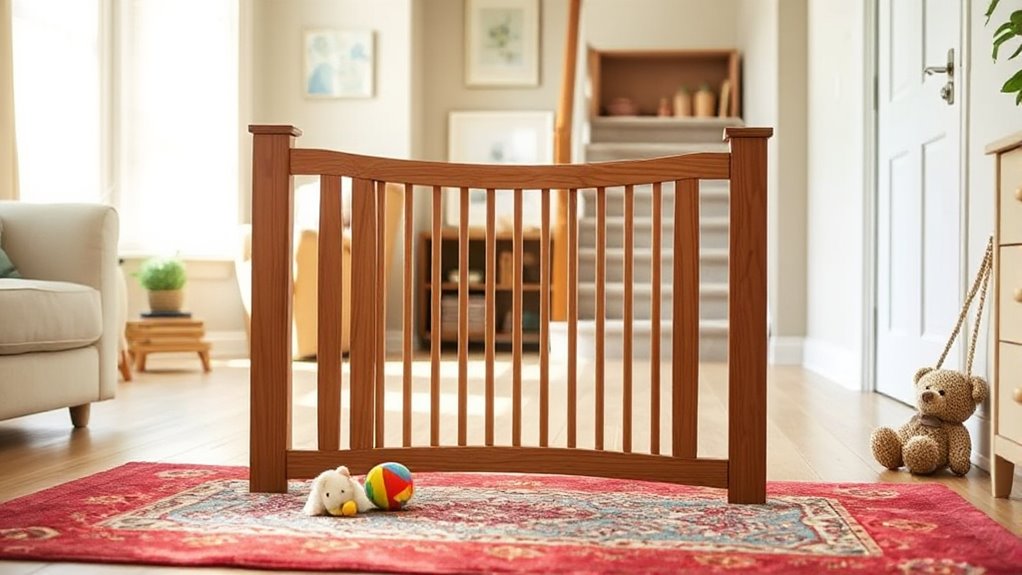Safety gates are essential for keeping your baby safe from household hazards. You’ll want to choose the right type for your space, whether it’s a pressure-mounted gate for doorways or a hardware-mounted gate for stairways. Look for features like a secure latch, walk-thru design, and auto-close mechanisms. Proper installation and regular checks are vital for functionality. Explore various options to find the best fit for your home and make your living spaces safer for little ones.
Key Takeaways
- Choose the right type of baby gate based on your home layout, using hardware-mounted gates for stairs and pressure-mounted gates for doorways.
- Ensure the gate meets safety standards, looking for JPMA certification for reliable child protection.
- Opt for features like a walk-thru design and secure latch mechanisms to balance convenience and safety.
- Regularly inspect gates for wear and stability, ensuring they remain functional and secure for your child.
- Install gates correctly and follow manufacturer instructions to maximize safety effectiveness in your home.
Types of Baby Gates
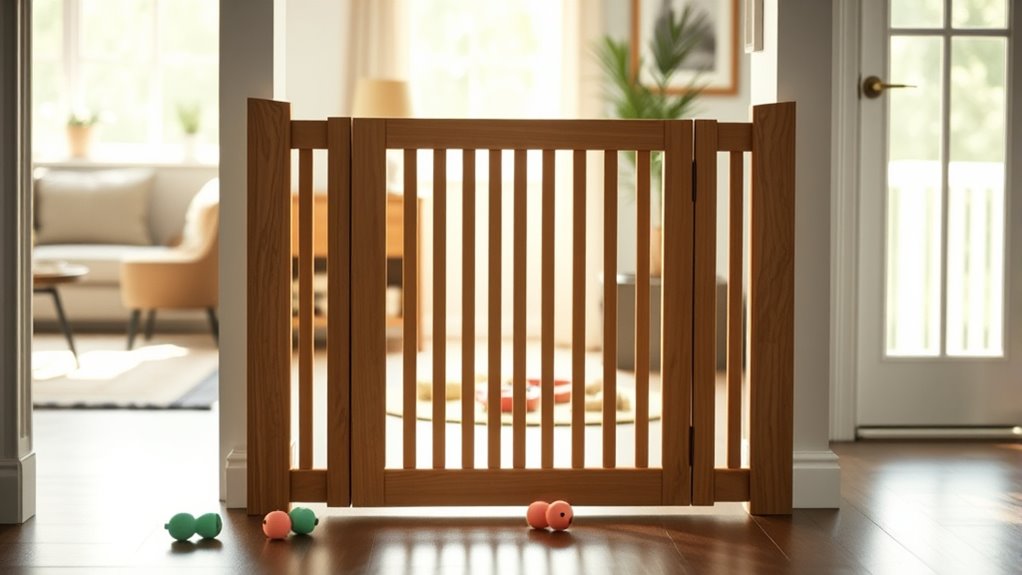
When it comes to keeping your little ones safe, understanding the different types of baby gates is essential.
You’ve got pressure-mounted gates that work well in doorways and hallways, installing easily without damaging walls, but steer clear of using them at the top of stairs. It’s important to ensure consistent routines to help children feel secure in their environment. Additionally, using vertical storage solutions can help clear pathways, ensuring a safer play area for your child.
For high-risk areas, hardware-mounted gates offer the stability you need.
Free-standing gates are great for creating temporary play areas, while retractable gates save space and secure openings up to 52 inches wide.
If you need something extra, consider extra-wide or super-wide gates, which can span openings up to 192 inches, providing versatility for various layouts.
Choosing the right safety gates can make all the difference in keeping your child protected. Additionally, ensuring safety in the home involves being aware of common types of scams that target parents and caregivers.
Choosing the Right Baby Gate
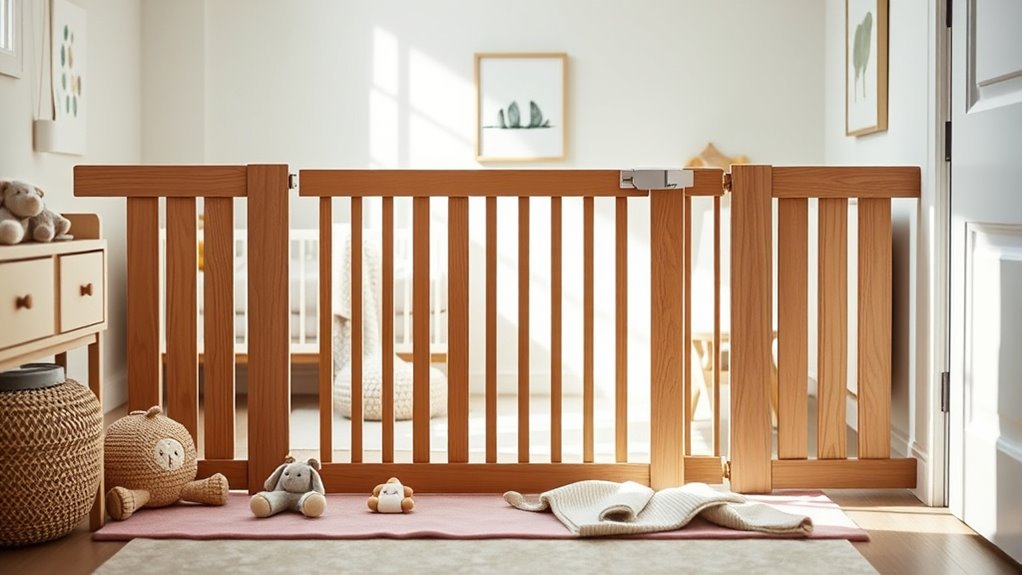
When choosing the right baby gate, start by evaluating your home layout and identifying your safety needs. You’ll want to compare different gate types to find the best fit for your space and lifestyle. Additionally, it’s important to ensure that the gate provides secure connections to prevent accidental openings and ensure your child’s safety. Having a well-defined safety plan can further enhance your child’s protection in various home environments. For instance, gates can be especially effective in preventing access to hazardous areas like staircases or kitchens, keeping your baby safe from potential dangers.
Assess Home Layout
To choose the right baby gate, evaluating your home layout is essential. Start by identifying the types of openings in your home; pressure-mounted gates work best for doorways and hallways, while hardware-mounted gates are safer for high-risk areas like the top of stairs.
Measure the width and height of these openings, as expandable gates can fit spaces up to 192 inches. Consider where you’ll install the gate—free-standing gates suit open areas, while retractable gates are great for tight spots. Additionally, many retailers offer competitive pricing on safety gates, making it easier to find a suitable option for your budget. Choosing a gate with user-friendly setup can also simplify the installation process.
Make certain your selected safety gate meets safety standards, like JPMA certification, to guarantee it’s secure. Additionally, understanding proper disposal habits can help keep your home environment safe and hygienic for your baby.
Finally, think about traffic patterns; walk-thru designs offer convenience while keeping your child safe in frequently used areas.
Identify Safety Needs
How can you guarantee your baby’s safety while traversing your home? Start by evaluating your layout and identifying high-risk areas, like stairways, where hardware-mounted baby gates are essential for secure installation.
For doorways and hallways, pressure-mounted gates offer an easy, damage-free solution. If you’re tight on space, consider retractable gates that provide safety without taking up room when not in use.
Don’t forget about extra-wide and super-wide options for those irregular openings; they help guarantee a perfect fit. Always check manufacturer specifications for safety recommendations, and make sure your chosen gate has JPMA certification to meet safety standards. Additionally, ensure that the gate you choose has appropriate safety features to prevent accidental openings by curious toddlers.
Compare Gate Types
Selecting the right baby gate involves comparing various types to find what best suits your home and lifestyle.
If you need a secure option for high-risk areas like the top of stairs, hardware-mounted gates are your best bet. They offer a sturdy installation that helps prevent accidents.
For doorways and hallways, consider pressure-mounted gates; they’re easy to install and remove, giving you flexibility.
If you need a gate in open spaces, free-standing gates can be relocated effortlessly.
Retractable gates are great for tight areas since they save space by expanding and retracting as needed.
Finally, if you have irregular openings, extra-wide gates can accommodate widths up to 192 inches, ensuring safety in your unique layout.
Features to Look For in Baby Gates
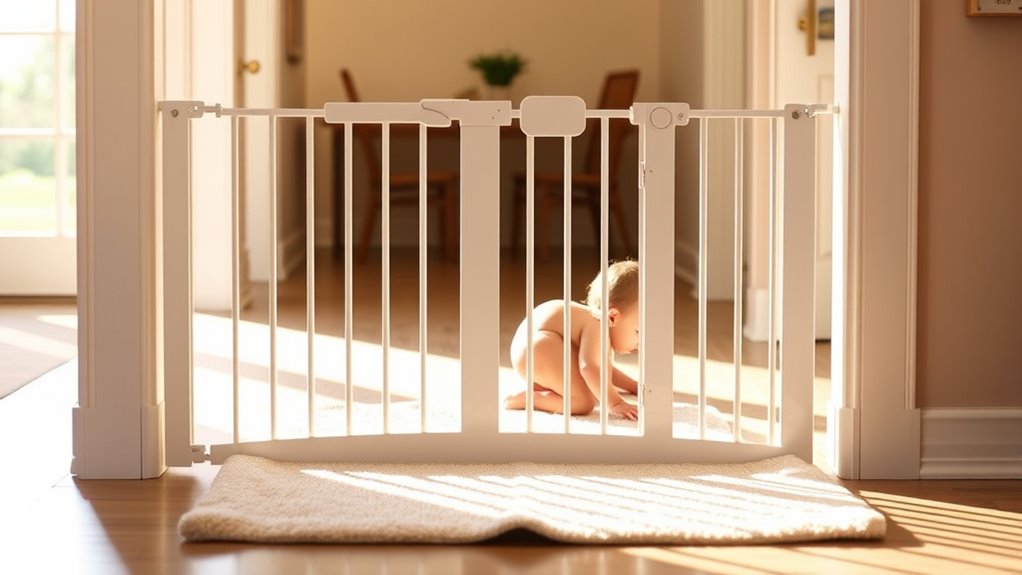
When choosing a baby gate, it’s vital to prioritize safety and convenience, ensuring that it fits seamlessly into your home.
Look for features that enhance both baby safety and ease of use. Here are three essential features to take into account:
- Walk-thru design: Allows adults to pass through easily without removing the gate.
- Secure latch mechanism: Prevents toddlers from opening it while remaining accessible for adults.
- Adjustable panels: Accommodates different widths, ensuring a snug fit in various locations.
Additionally, think about gates with a slat design for visibility and auto-close mechanisms that enhance safety by closing automatically after being opened.
These features not only make the gate easy to install but also provide peace of mind as your little one explores.
Installation Locations for Baby Gates
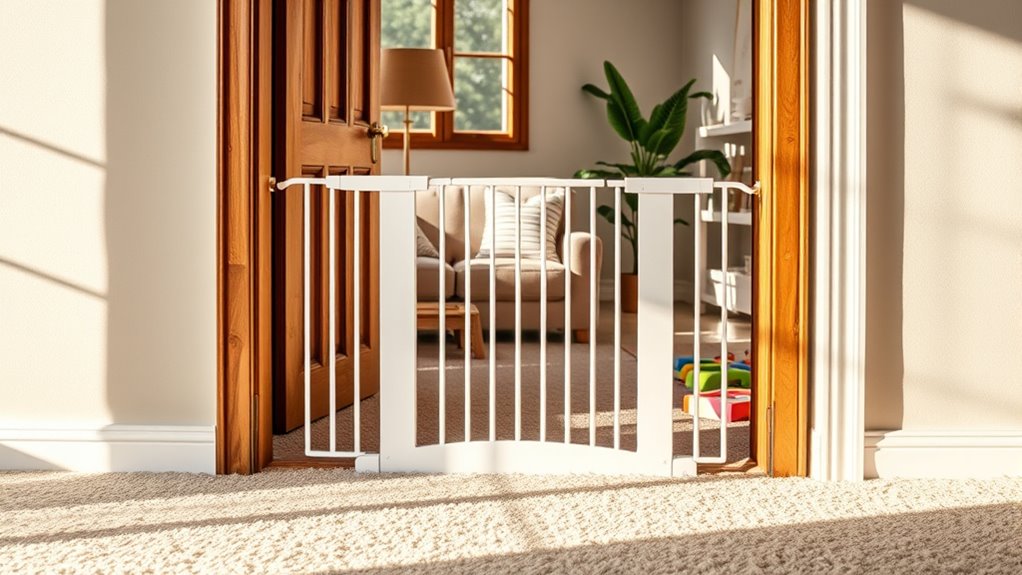
Choosing the right installation locations for baby gates is essential for keeping your little one safe.
Start by placing hardware-mounted gates at the top of stairs to prevent accidental falls. For hallways and doorways, pressure-mounted gates work great, offering security without damaging your walls.
If you have an open-concept living area, consider extra-wide gates to create safe play zones for your child. Free-standing gates are perfect for temporary setups, easily relocating them to playrooms or near fireplaces.
Finally, modular systems can cover larger spaces, allowing you to customize configurations based on your specific child safety needs.
Top Picks for Safety Gates
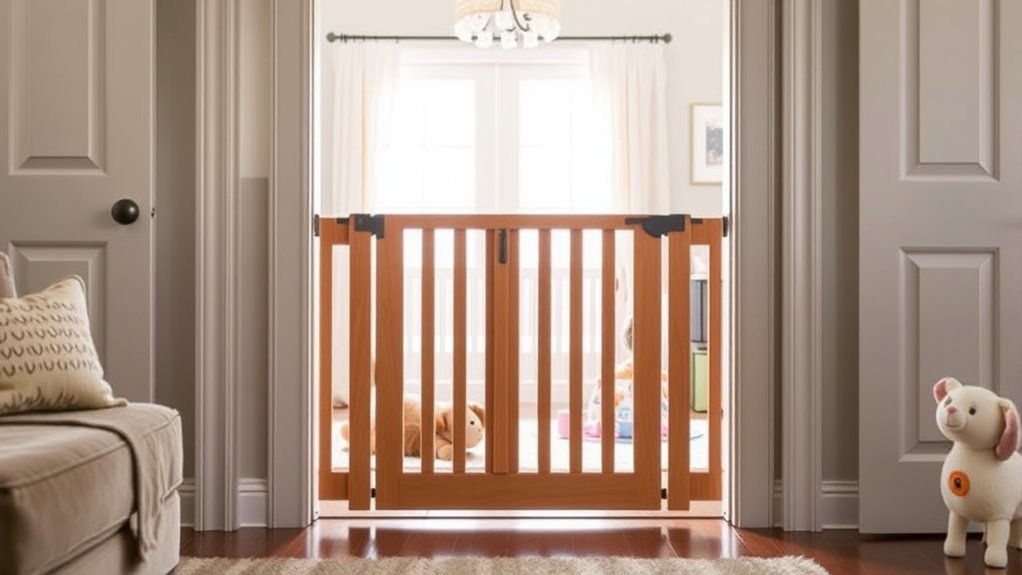
Finding the right safety gate for your home can make a huge difference in keeping your little one secure. Here are some top picks for safety gates that you should consider:
- Cardinal Gates SS-30 Stairway Special: This all-metal gate is your best overall choice for stair safety, featuring a simple latch that installs in under 20 minutes.
- North States Easy Swing & Lock Gate: A cost-effective option, it fits openings between 28.68 inches and 47.85 inches, though its plastic locking mechanism isn’t as durable.
- Smart Retract Retract-A-Gate: Ideal for tight spaces, this fabric gate fits openings up to 52 inches wide and eliminates the need for a swinging motion.
Each of these safety gates has been tested for stability and ease of installation, ensuring reliable security for your child.
Testing and Expert Recommendations
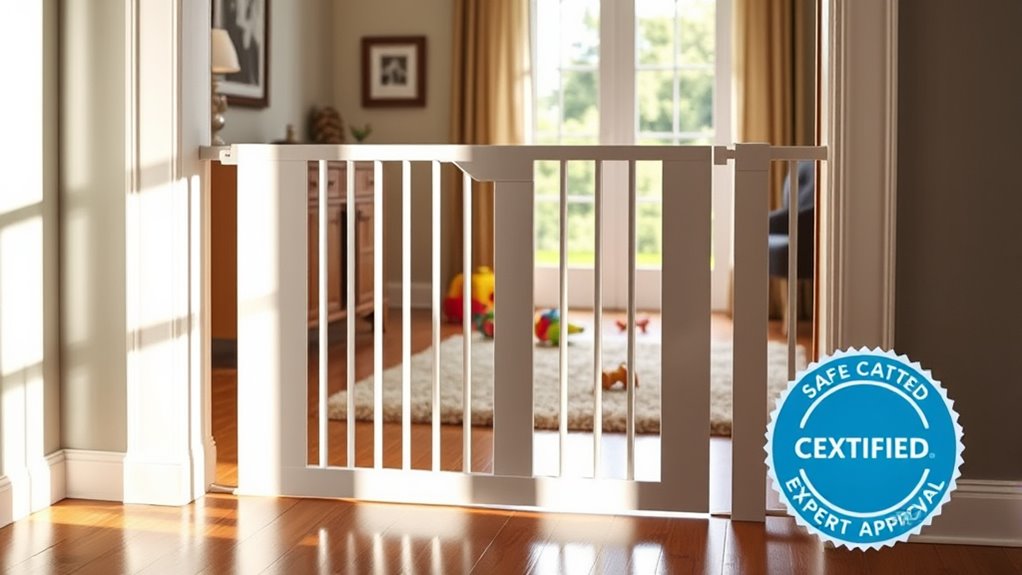
To guarantee you select the safest and most reliable gate for your home, testing and expert recommendations play an essential role.
Gates undergo rigorous testing to assess stability by repeatedly opening, closing, and applying force, confirming durability and usability. Real-world usage tests monitor gates with children over weeks, evaluating their practicality and effectiveness in everyday situations.
Experts recommend Cardinal Gates, particularly the SS-30 model, for its robust construction and secure locking mechanism, receiving positive feedback from long-term users.
It’s vital to ascertain that all selected gates come with JPMA certification, confirming they meet safety standards.
Additionally, the ease of installation, highlighted by clear instructions, greatly influences user satisfaction, making your choice even easier.
Key Features and Considerations

When selecting a baby gate, it’s important to take into account several key features that guarantee safety and convenience.
Selecting a baby gate requires careful consideration of essential features to ensure both safety and convenience.
Look for gates that prioritize sturdiness and ease of use, especially if you have an active little one. Here are some important features to keep in mind:
- JPMA Certification: Confirms the gate meets child safety standards.
- Hardware-Mounted Design: Ideal for high-risk areas like the top of stairs, providing maximum stability.
- One-Handed Operation: Makes it easier to open the gate while holding your child or carrying items.
If you need extra height, opt for extra tall gates to prevent climbing.
Additional Information on Baby Gates
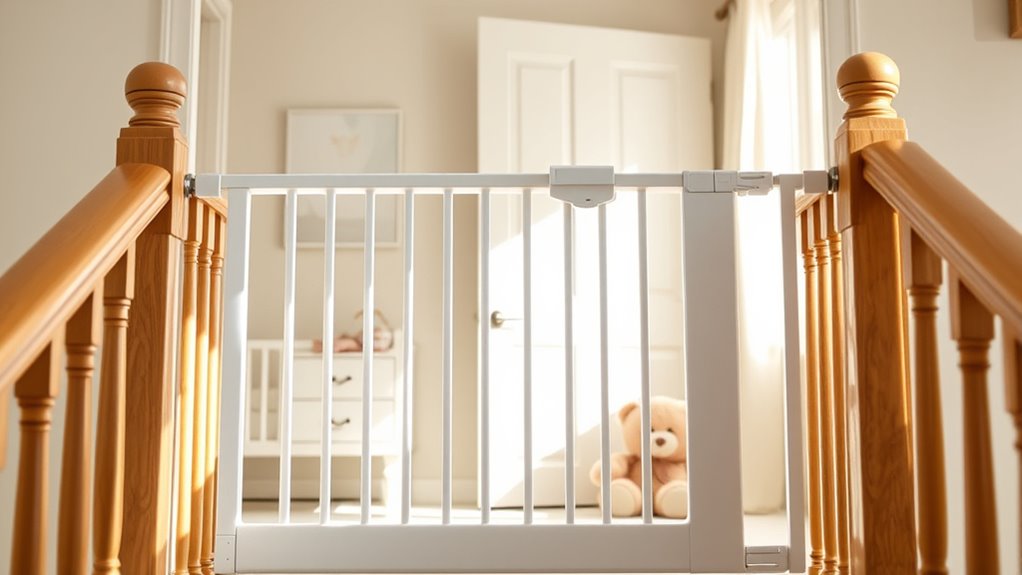
When choosing a baby gate, it’s important to understand the different types available, like pressure-mounted and hardware-mounted options.
You’ll want to take into account the installation safety of each type to guarantee your home is secure for your little one.
Let’s explore how these factors can impact your decision and keep your child safe.
Gate Types Overview
While choosing the right baby gate, it’s essential to understand the different types available, as each serves a specific purpose.
Here’s a quick overview of popular gate types:
- Pressure-mounted gates: Ideal for doorways and hallways, they install easily without damaging walls.
- Hardware-mounted gates: Best for high-risk areas like the top of stairs, providing enhanced security.
- Retractable gates: Perfect for tight spaces, they fit openings up to 52 inches wide and save space when not in use.
Each gate type offers unique features to keep your baby safe while accommodating wide openings and varying home decors.
Make sure you choose one that fits your needs and lifestyle!
Installation Safety Considerations
Choosing the right baby gate is just the first step; proper installation is key to ensuring your child’s safety.
When you install baby gates, always use hardware-mounted gates at the top of stairs for maximum security against accidental falls. Make sure the gate has JPMA certification to confirm it meets safety standards.
Carefully follow manufacturer instructions to achieve the correct fit, particularly with adjustable panels for different widths. Opt for gates with a walk-thru design and secure latch mechanisms that can be easily operated with one hand.
Regularly inspect the gates for durability and stability, checking for any signs of wear or damage. Keeping these considerations in mind will help maintain a safe environment for your little one.
Frequently Asked Questions
How Can You Prevent Accidents From Happening With a Baby Gate?
To prevent accidents with a baby gate, make certain you install it securely, preferably with hardware mounts at the top of stairs.
Check for auto-close mechanisms and strong latches to keep it closed when not in use.
Regularly inspect the gate for wear and tear, and make sure it fits tightly to avoid gaps.
Opt for JPMA certified gates to guarantee they meet safety standards, giving you peace of mind while your child explores.
Are Pet Gates Safe for Babies?
Pet gates aren’t safe for babies. They often lack the secure locking mechanisms and height needed to keep your child protected.
You’ll find that pet gates are usually shorter, making it easy for a curious toddler to climb over or crawl under them.
Plus, they mightn’t be sturdy enough to withstand a child’s attempts to push them.
Always choose gates specifically designed for babies to guarantee their safety and well-being.
What Is an Alternative to a Baby Gate?
If you’re looking for an alternative to a baby gate, consider using playpens. They create a safe, enclosed space for your little one to play without the risk of wandering into dangerous areas.
Another option is baby fences, which can be arranged in various shapes to suit your home.
You might also think about retractable gates for temporary use or portable barriers for outdoor safety, allowing for flexibility and peace of mind.
What Age Do You Stop Using Safety Gates?
As your little explorer transforms into a curious adventurer, you’ll find yourself wondering when to bid farewell to safety gates.
Typically, you can consider removing them between ages 2 to 3, but it’s all about your child’s unique journey. If they can climb over or open the latch, it’s time to reassess.
Keep an eye on their understanding of boundaries—once they navigate stairs safely, you’ll know it’s time to let them roam free!
Conclusion
In the journey of parenthood, baby gates are the sturdy bridges that keep your little explorer safe from potential hazards. Just as a lighthouse guides ships to shore, the right gate helps you navigate your home with confidence. By choosing wisely and installing them thoughtfully, you create a protective haven where your child can thrive. Remember, these gates aren’t just barriers; they symbolize your love and commitment to keeping your baby safe as they discover the world around them.
